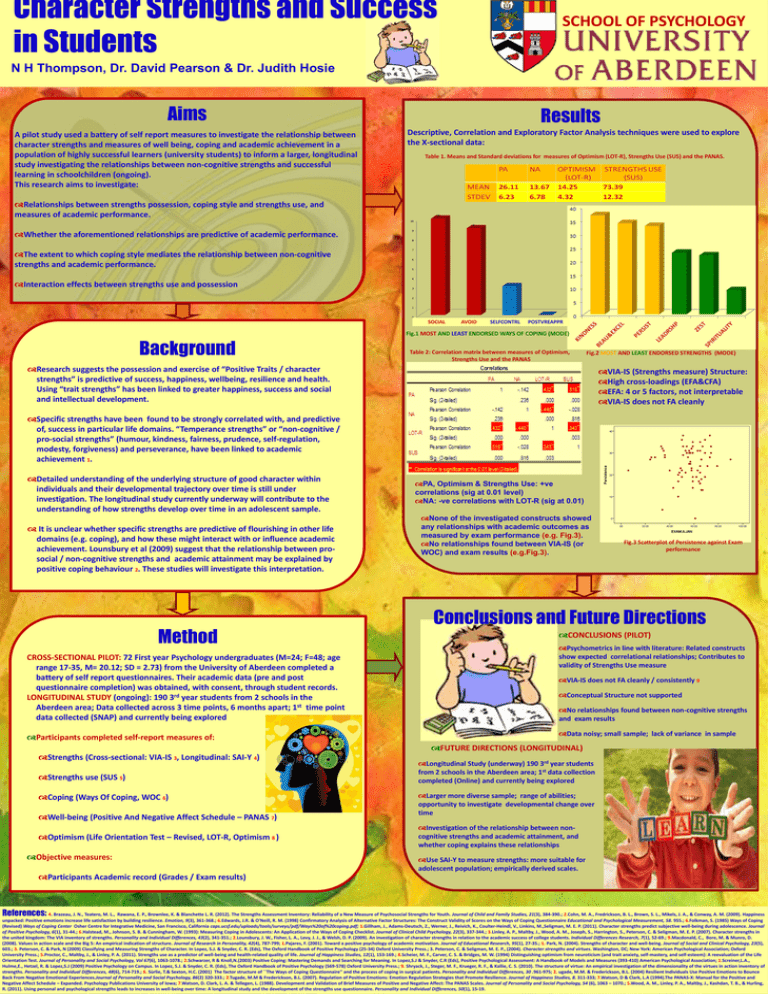PosterPresentationConference_Nicola_ThompsonRedraft
advertisement

Character Strengths and Success in Students SCHOOL OF PSYCHOLOGY N H Thompson, Dr. David Pearson & Dr. Judith Hosie Aims A pilot study used a battery of self report measures to investigate the relationship between character strengths and measures of well being, coping and academic achievement in a population of highly successful learners (university students) to inform a larger, longitudinal study investigating the relationships between non-cognitive strengths and successful learning in schoolchildren (ongoing). This research aims to investigate: Results Descriptive, Correlation and Exploratory Factor Analysis techniques were used to explore the X-sectional data: Table 1. Means and Standard deviations for measures of Optimism (LOT-R), Strengths Use (SUS) and the PANAS. Relationships between strengths possession, coping style and strengths use, and measures of academic performance. 10 10 9 Whether the aforementioned relationships are predictive of academic performance. 9 8 The extent to which coping style mediates the relationship between non-cognitive strengths and academic performance. Interaction effects between strengths use and possession 7 6 5 4 3 2 1 0 SOCSUP SOCIAL ESCAVOID AVOID SELFCON SELFCONTRL POSREAPP POSTVREAPPR Fig.1 MOST AND LEAST ENDORSED WAYS OF COPING (MODE) Background Table 2: Correlation matrix between measures of Optimism, Strengths Use and the PANAS Fig.2 MOST AND LEAST ENDORSED STRENGTHS (MODE) Research suggests the possession and exercise of “Positive Traits / character strengths” is predictive of success, happiness, wellbeing, resilience and health. Using “trait strengths” has been linked to greater happiness, success and social and intellectual development. VIA-IS (Strengths measure) Structure: High cross-loadings (EFA&CFA) EFA: 4 or 5 factors, not interpretable VIA-IS does not FA cleanly Specific strengths have been found to be strongly correlated with, and predictive of, success in particular life domains. “Temperance strengths” or “non-cognitive / pro-social strengths” (humour, kindness, fairness, prudence, self-regulation, modesty, forgiveness) and perseverance, have been linked to academic achievement 1. Detailed understanding of the underlying structure of good character within individuals and their developmental trajectory over time is still under investigation. The longitudinal study currently underway will contribute to the understanding of how strengths develop over time in an adolescent sample. It is unclear whether specific strengths are predictive of flourishing in other life domains (e.g. coping), and how these might interact with or influence academic achievement. Lounsbury et al (2009) suggest that the relationship between prosocial / non-cognitive strengths and academic attainment may be explained by positive coping behaviour 2. These studies will investigate this interpretation. Method CROSS-SECTIONAL PILOT: 72 First year Psychology undergraduates (M=24; F=48; age range 17-35, M= 20.12; SD = 2.73) from the University of Aberdeen completed a battery of self report questionnaires. Their academic data (pre and post questionnaire completion) was obtained, with consent, through student records. LONGITUDINAL STUDY (ongoing): 190 3rd year students from 2 schools in the Aberdeen area; Data collected across 3 time points, 6 months apart; 1st time point data collected (SNAP) and currently being explored Participants completed self-report measures of: PA, Optimism & Strengths Use: +ve correlations (sig at 0.01 level) NA: -ve correlations with LOT-R (sig at 0.01) None of the investigated constructs showed any relationships with academic outcomes as measured by exam performance (e.g. Fig.3). No relationships found between VIA-IS (or WOC) and exam results (e.g.Fig.3). Fig.3 Scatterplot of Persistence against Exam performance Conclusions and Future Directions CONCLUSIONS (PILOT) Psychometrics in line with literature: Related constructs show expected correlational relationships; Contributes to validity of Strengths Use measure VIA-IS does not FA cleanly / consistently 9 Conceptual Structure not supported No relationships found between non-cognitive strengths and exam results Data noisy; small sample; lack of variance in sample FUTURE DIRECTIONS (LONGITUDINAL) Strengths (Cross-sectional: VIA-IS 3, Longitudinal: SAI-Y 4) Strengths use (SUS 5) Coping (Ways Of Coping, WOC 6) Well-being (Positive And Negative Affect Schedule – PANAS 7) Optimism (Life Orientation Test – Revised, LOT-R, Optimism 8 ) Objective measures: Longitudinal Study (underway) 190 3rd year students from 2 schools in the Aberdeen area; 1st data collection completed (Online) and currently being explored Larger more diverse sample; range of abilities; opportunity to investigate developmental change over time Investigation of the relationship between noncognitive strengths and academic attainment, and whether coping explains these relationships Use SAI-Y to measure strengths: more suitable for adolescent population; empirically derived scales. Participants Academic record (Grades / Exam results) References: 4. Brazeau, J. N., Teatero, M. L., Rawana, E. P., Brownlee, K. & Blanchette L. R. (2012). The Strengths Assessment Inventory: Reliability of a New Measure of Psychosocial Strengths for Youth. Journal of Child and Family Studies, 21(3), 384-390.; 2.Cohn, M. A., Fredrickson, B. L., Brown, S. L., Mikels, J. A., & Conway, A. M. (2009). Happiness unpacked: Positive emotions increase life satisfaction by building resilience. Emotion, 9(3), 361-368.; 6.Edwards, J.R. & O'Neill, R. M. (1998) Confirmatory Analysis of Alternative Factor Structures: The Construct Validity of Scores on the Ways of Coping Questionnaire Educational and Psychological Measurement, 58. 955.; 6.Folkman, S. (1985) Ways of Coping (Revised) Ways of Coping Center Osher Centre for Integrative Medicine, San Francisco, California caps.ucsf.edu/uploads/tools/surveys/pdf/Ways%20of%20coping.pdf; 1.Gillham, J., Adams-Deutsch, Z., Werner, J., Reivich, K., Coulter-Heindl, V., Linkins, M.,Seligman, M. E. P. (2011). Character strengths predict subjective well-being during adolescence. Journal of Positive Psychology, 6(1), 31-44.; 6.Halstead, M., Johnson, S. B. & Cunningham, W. (1993): Measuring Coping in Adolescents: An Application of the Ways of Coping Checklist. Journal of Clinical Child Psychology, 22(3), 337-344.; 3.Linley, A. P., Maltby, J., Wood, A. M., Joseph, S., Harrington, S., Peterson, C. & Seligman, M. E. P. (2007). Character strengths in the united kingdom: The VIA inventory of strengths. Personality and Individual Differences, 43(2), 341-351.; 2.Lounsbury, J. W., Fisher, L. A., Levy, J. J., & Welsh, D. P. (2009). An investigation of character strengths in relation to the academic success of college students. Individual Differences Research, 7(1), 52-69.; 9.Macdonald, C., Bore, M. & Munro, D. (2008). Values in action scale and the Big 5: An empirical indication of structure. Journal of Research in Personality, 42(4), 787-799; 1.Pajares, F. (2001). Toward a positive psychology of academic motivation. Journal of Educational Research, 95(1), 27-35.; 1. Park, N. (2004). Strengths of character and well-being. Journal of Social and Clinical Psychology, 23(5), 603.; 3. Peterson, C. & Park, N (2009) Classifying and Measuring Strengths of Character. In Lopez, S.J. & Snyder, C. R. (Eds), The Oxford Handbook of Positive Psychology (25-34) Oxford University Press.; 3. Peterson, C. & Seligman, M. E. P., (2004). Character strengths and virtues. Washington, DC; New York: American Psychological Association; Oxford University Press.; 5.Proctor, C., Maltby, J., & Linley, P. A. (2011). Strengths use as a predictor of well-being and health-related quality of life. Journal of Happiness Studies, 12(1), 153-169.; 8.Scheier, M. F., Carver, C. S. & Bridges, M. W. (1994) Distinguishing optimism from neuroticism (and trait anxiety, self-mastery, and self-esteem): A reevaluation of the Life Orientation Test. Journal of Personality and Social Psychology, Vol 67(6), 1063-1078.; 2.Schwarzer, R & Knoll,N.(2003) Positive Coping: Mastering Demands and Searching for Meaning. In Lopez,S.J & Snyder, C.R (Eds), Positive Psychological Assessment: A Handbook of Models and Measures (393-410) American Psychological Association; 1.Screiner,L.A., Hulme,E., Hetzel, R. & Lopez,S.J (2009) Positive Psychology on Campus. In Lopez, S.J. & Snyder, C. R. (Eds), The Oxford Handbook of Positive Psychology (569-578) Oxford University Press.; 9. Shryack, J., Steger, M. F., Krueger, R. F., & Kallie, C. S. (2010). The structure of virtue: An empirical investigation of the dimensionality of the virtues in action inventory of strengths. Personality and Individual Differences, 48(6), 714-719.; 6. Sùrlie, T.& Sexton, H.C. (2001) The factor structure of ``The Ways of Coping Questionnaire'' and the process of coping in surgical patients. Personality and Individual Differences, 30 .961-975; 2. ugade, M.M. & Frederickson, B.L. (2004) Resilient Individuals Use Positive Emotions to Bounce Back From Negative Emotional Experiences.Journal of Personality and Social Psychology, 86(2) 320-333.; 2.Tugade, M.M & Frederickson, B.L. (2007). Regulation of Positive Emotions: Emotion Regulation Strategies that Promote Resilience. Journal of Happiness Studies, 8. 311-333; 7.Watson, D & Clark, L.A (1994).The PANAS-X: Manual for the Positive and Negative Affect Schedule – Expanded. Psychology Publications University of Iowa; 7.Watson, D. Clark, L. A. & Tellegen, L. (1988). Development and Validation of Brief Measures of Positive and Negative Affect: The PANAS Scales. Journal of Personality and Social Psychology, 54 (6), 1063 – 1070.; 5.Wood, A. M., Linley, P. A., Maltby, J., Kashdan, T. B., & Hurling, R. (2011). Using personal and psychological strengths leads to increases in well-being over time: A longitudinal study and the development of the strengths use questionnaire. Personality and Individual Differences, 50(1), 15-19.





